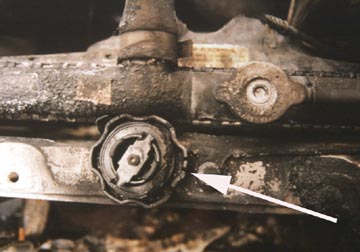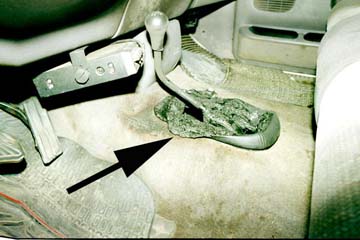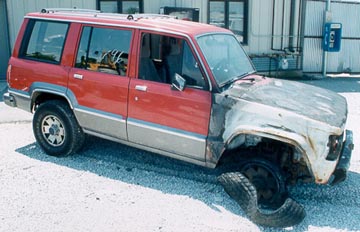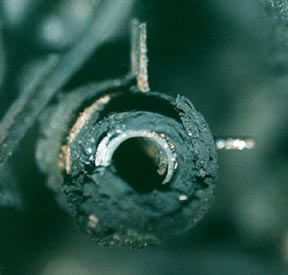
Figure 1

Figure 2
Figure 2 is a view of the engine compartment with the arrow pointing to the oil filler cap, which was missing from the vehicle. Burn patterns indicate that the cap was not on the oil filler neck at the time of the fire. Crankcase pressure expelled oil out of the filler neck onto hot exhaust components, causing the fire. The insured had no knowledge of why the cap was not on the vehicle other than he performed his own maintenance. Subrogation potential on this loss is low.

Figure 3
Figure 3 shows an oil filler neck cap found on the radiator of a vehicle that caught fire shortly after leaving a service station, after an oil change. Engine oil had been blown out of the oil filler neck onto hot engine components, causing the fire. The oil cap must be removed to pour fresh oil into the engine. Apparently, the service personnel did not properly install the cap on the oil filler neck. Subrogation potential against the service station is higher in this case.

Figure 4
Figure 4 is a view of the occupant compartment of a pick-up truck with the arrow pointing at a burned shift lever boot and carpeting. A fire developed under the transmission boot area while the vehicle was towing a heavy load, which was within the capability of the vehicle. Figure 5 is a view under the vehicle with an arrow pointing to a transmission oil cooler tube fitting that apparently leaked transmission fluid, which then sprayed all over the undercarriage of the vehicle. The transmission oil sprayed onto the exhaust pipe, causing a fire in the vicinity of the transmission oil leak. A recall had just been implemented regarding the transmission oil fittings. According to the manufacturer, under certain conditions, the plastic fittings could not handle the high temperatures associated with hot transmission oil. The recall requires replacement fittings to be installed that can handle the high transmission oil temperatures. In this case, the subrogation potential is high.

Figure 5

Figure 6
Figure 6 is a view of a sports utility vehicle that developed an engine compartment fire while driving on an interstate highway. Burn patterns indicate a fire origin at the left side of the engine, in the engine compartment. A recall notice that had just been received by the insured, indicated a design problem with a rubber oil cooler hose (Figure 7) that tended to deteriorate because of heat from the exhaust manifold. The hose was to be replaced with a more heat resistive material. This was a vehicle design issue with a good chance of recovery from the vehicle manufacturer.

Figure 7
Subrogation potential is highly dependant on the results of the examination of the vehicle. The examples shown above depict significant evidence to support or reject subrogation. It is not uncommon to find a badly damaged vehicle with little evidence remaining. If the fire in Figure 4 had not been extinguished early and had been allowed to burn to completion, there would most likely have been little evidence remaining to opine on where the fire started, yielding a low subrogation potential. Older vehicles are prone to wear out and maintenance related problems with a lower recovery value unless some other property is involved such as a home.
REFERENCES:
1. Roberts, Charles C., Jr., “Motor Vehicle Fire Analysis,” Automotive Engineering and Litigation, Volume 4, John Wiley and Sons, 1991.
2. Roberts, Charles C., Jr., “Technical Aspects of Insurance Claims Investigations,” Roberts Publishing, 2002.
3. Roberts, Charles C., Jr., “Automotive Vehicle Fire Analysis,” Roberts Publishing, 2003.
BACK TO C. ROBERTS CONSULTING ENGINEERS HOME PAGE,
WWW.CROBERTS.COM

Figure 3

Figure 4
Figure 4 is a view of the occupant compartment of a pick-up truck with the arrow pointing at a burned shift lever boot and carpeting. A fire developed under the transmission boot area while the vehicle was towing a heavy load, which was within the capability of the vehicle. Figure 5 is a view under the vehicle with an arrow pointing to a transmission oil cooler tube fitting that apparently leaked transmission fluid, which then sprayed all over the undercarriage of the vehicle. The transmission oil sprayed onto the exhaust pipe, causing a fire in the vicinity of the transmission oil leak. A recall had just been implemented regarding the transmission oil fittings. According to the manufacturer, under certain conditions, the plastic fittings could not handle the high temperatures associated with hot transmission oil. The recall requires replacement fittings to be installed that can handle the high transmission oil temperatures. In this case, the subrogation potential is high.

Figure 5

Figure 6
Figure 6 is a view of a sports utility vehicle that developed an engine compartment fire while driving on an interstate highway. Burn patterns indicate a fire origin at the left side of the engine, in the engine compartment. A recall notice that had just been received by the insured, indicated a design problem with a rubber oil cooler hose (Figure 7) that tended to deteriorate because of heat from the exhaust manifold. The hose was to be replaced with a more heat resistive material. This was a vehicle design issue with a good chance of recovery from the vehicle manufacturer.

Figure 7
Subrogation potential is highly dependant on the results of the examination of the vehicle. The examples shown above depict significant evidence to support or reject subrogation. It is not uncommon to find a badly damaged vehicle with little evidence remaining. If the fire in Figure 4 had not been extinguished early and had been allowed to burn to completion, there would most likely have been little evidence remaining to opine on where the fire started, yielding a low subrogation potential. Older vehicles are prone to wear out and maintenance related problems with a lower recovery value unless some other property is involved such as a home.
REFERENCES:
1. Roberts, Charles C., Jr., “Motor Vehicle Fire Analysis,” Automotive Engineering and Litigation, Volume 4, John Wiley and Sons, 1991.
2. Roberts, Charles C., Jr., “Technical Aspects of Insurance Claims Investigations,” Roberts Publishing, 2002.
3. Roberts, Charles C., Jr., “Automotive Vehicle Fire Analysis,” Roberts Publishing, 2003.
BACK TO C. ROBERTS CONSULTING ENGINEERS HOME PAGE,
WWW.CROBERTS.COM

Figure 5

Figure 6

Figure 7
Subrogation potential is highly dependant on the results of the examination of the vehicle. The examples shown above depict significant evidence to support or reject subrogation. It is not uncommon to find a badly damaged vehicle with little evidence remaining. If the fire in Figure 4 had not been extinguished early and had been allowed to burn to completion, there would most likely have been little evidence remaining to opine on where the fire started, yielding a low subrogation potential. Older vehicles are prone to wear out and maintenance related problems with a lower recovery value unless some other property is involved such as a home.
REFERENCES:
1. Roberts, Charles C., Jr., “Motor Vehicle Fire Analysis,” Automotive Engineering and Litigation, Volume 4, John Wiley and Sons, 1991.
2. Roberts, Charles C., Jr., “Technical Aspects of Insurance Claims Investigations,” Roberts Publishing, 2002.
3. Roberts, Charles C., Jr., “Automotive Vehicle Fire Analysis,” Roberts Publishing, 2003.
BACK TO C. ROBERTS CONSULTING ENGINEERS HOME PAGE,
WWW.CROBERTS.COM
WWW.CROBERTS.COM